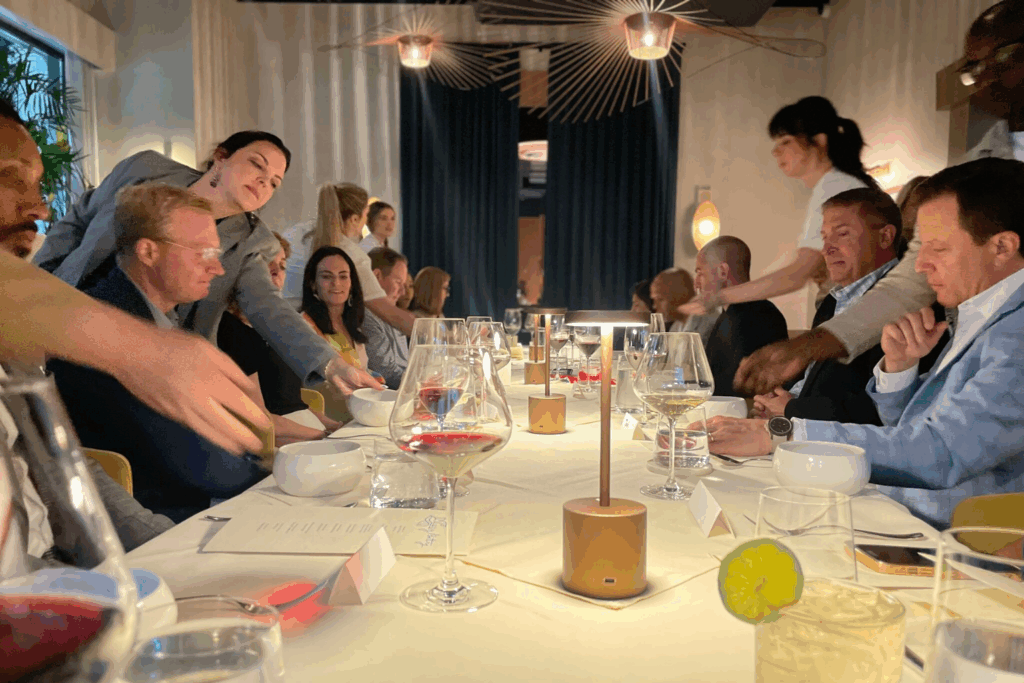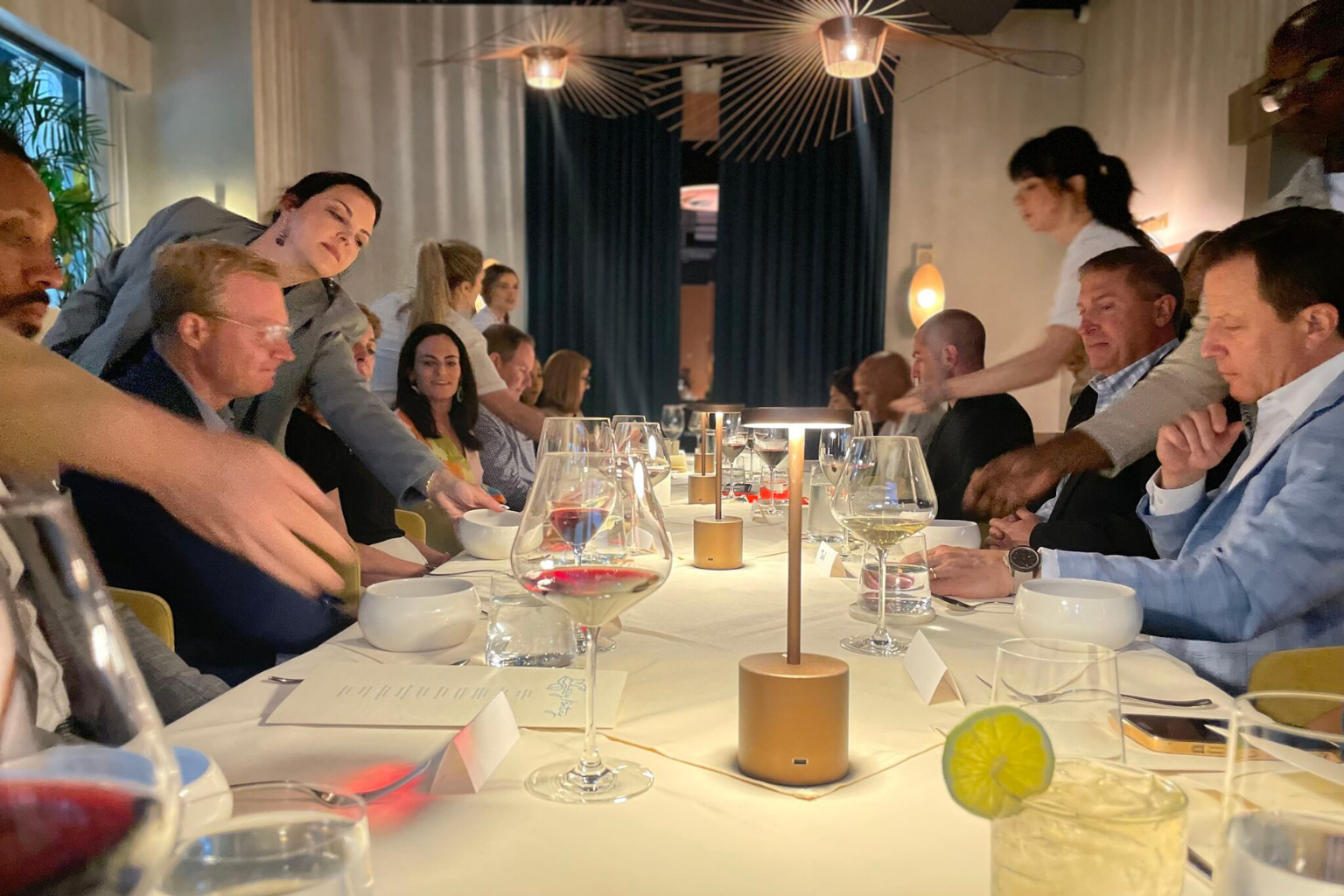
We gathered C-suite HR leaders for dinner conversations about the future of work. Here are the most powerful insights that emerged.
By Moses Berkowitz, Chief Business Officer, Censia
In this article, you’ll gain insights into:
- Why CHROs are shifting from job-based planning to capability-first strategies in response to AI and skills disruption
- How leading organizations are designing for agility and empowerment instead of relying on traditional bureaucracy
- The evolving role of HR leaders as strategic architects of the future workforce rather than stewards of HR processes
Over the past few months, we gathered C-suite HR leaders from Atlanta, New York, and other major cities for roundtable dinners. What emerged from those conversations was striking: every leader recognized that we’ve reached a defining moment in how organizations approach talent and the future of work. At every gathering, it was clear that HR leaders wanted to do more than simply respond to change. They wanted to be actively driving the direction forward.
The rich discussions underscored why today’s HR leaders have become the architects of tomorrow’s workplace. Here are five takeaways that emerged:
1. The Skills Revolution: AI Doesn’t Replace Jobs, It Replaces Skills
One powerful insight emerged repeatedly during our dinners: the entire conversation about AI and jobs misses the point. As one HR executive put it, “AI doesn’t replace jobs—it replaces skills.” This reframing changes everything.
Consider this: jobs are simply bundles of skills. And if humans can learn new skills while organizations need great talent to compete, then we’re asking the wrong question. Instead of wondering whether your workforce will survive AI, we should be asking: Are you preparing them for the skills they’ll need tomorrow?
Here’s what surprised us. Nearly every CHRO acknowledged an uncomfortable truth: while they intellectually understand the need for skills-based thinking, most are still hiring based on degrees and job titles. The gap between intention and action is real and it’s widening.
Data backs this up. McKinsey’s 2025 research shows that 46% of leaders cite skill gaps as their primary barrier to AI adoption. Yet our dinner conversations revealed something more nuanced: the most forward-thinking organizations aren’t just closing today’s skill gaps. They’re predicting tomorrow’s skills.
Consider the scale of change ahead: Workers can expect 39% of their existing skills to be transformed by 2030, with generative AI having a particularly significant impact on knowledge workers. But that prediction isn’t a distant threat. It’s happening now.
The breakthrough came when our HR guests shifted their fundamental question from “What roles do we need to fill?” to “What capabilities do we need to build?” That single change in language transforms how organizations approach talent strategy.
The bottom line: Start thinking in capability portfolios, not job descriptions. Build learning systems designed to evolve faster than the skills they teach. The future belongs to organizations that can learn faster than the pace of change.
2. The Permission Paradox: Building Organizations for Possibility
The future of work won’t be built by permission. It will be built by possibility.
This belief emerged from one of our most engaging dinner conversations, where HR leaders grappled with a fundamental challenge: how do you create organizations that can move at the speed of opportunity when traditional structures require approval at every turn?
Enter leadership and business strategist Rita McGrath, whose upcoming work on “permissionless” organizations provided the framework we needed. Her core insight resonated immediately: the most adaptive organizations don’t just reduce approval layers. They fundamentally redesign how decisions get made. Teams are empowered to act, innovate, and respond without waiting for permission.
The data confirms what these leaders feel daily. Deloitte’s 2025 Global Human Capital Trends survey reveals that while 72% of organizations recognize the importance of striking a balance between agility and stability, only 39% are taking meaningful action to achieve this balance. Meanwhile, 85% of business executives say organizations need to create more agile ways of organizing work to adapt to market changes.
That isn’t a contradiction; it’s a design challenge. The most successful organizations are mastering what Deloitte researchers call “stagility”: creating stable foundations that enable agile action.
McGrath challenged our group with six questions that cut to the heart of permissionless design:
- Simplicity First: “What would you eliminate if complexity were the enemy?” Simple structures enable fast action.
- Smart Connections: “Where are dependencies creating bottlenecks?” Not everything needs to be connected to everything else.
- Long-term Thinking: “Are you building for this quarter or the next generation?” Stewardship beats short-termism.
- True Diversity: “Do you have diversity of thought, not just demographics?” Innovation requires varied perspectives and experiences.
- Continuous Learning: “How fast do you learn from failure?” Real feedback loops don’t wait for annual reviews.
- Space for Surprise: “Where can the unexpected happen?” Innovation needs room to breathe.
What struck us most was how these questions reframe the entire conversation. Instead of asking “How can we control outcomes?” leaders started asking “How can we enable possibilities?”
The path forward became clear through our discussions. Organizations that thrive won’t be those with the best approval processes. They’ll be those that need the fewest approvals. They’ll create stable platforms that give people both the security they need and the freedom to act on opportunities as they emerge.
The bottom line: Stop designing for control. Start planning for possibility. Build organizations where permission is built into the structure, rather than being requested at every turn. That’s how you create workplaces that move at the speed of opportunity while giving people the stability they need to do their best work.
3. The Complexity Trap: Why Everyone Feels Overwhelmed
“Every leader I know feels it. So do their teams.”
This confession captured what every leader at our dinners was experiencing: the realization that the systems we’ve built weren’t designed for this level of complexity, this pace of change, or this much uncertainty.
However, a breakthrough moment emerged during our conversations: complexity isn’t the problem. Unclear complexity is the problem. The most successful organizations are those that can name their complexity, organize it, and help their people navigate it.
McKinsey’s latest research on operating models confirms this approach. They found that companies need an effective operating model that is intentionally designed to deliver four outcomes that all organizations covet: clarity, speed, skills, and commitment. Notably, clarity comes first.
As the McKinsey research explains: “In volatile times, it’s essential that CEOs can see for themselves how resources and teams deployed throughout the organization reflect strategic priorities. By clarifying who is accountable for this value agenda, the whole organization can navigate change and replace bureaucratic layers with flexible teams that have a clear sense of purpose.”
The bottom line: Stop trying to simplify what’s inherently complex. Instead, become brilliant at helping your people navigate complexity with confidence. When you can’t reduce the chaos, create clarity within it. That’s how overwhelmed teams become empowered ones.
4. The End of Traditional Succession Planning: “Do We Have the Right Readiness?”
What we used to ask: “Do we have a succession plan?” What leaders are asking now: “Do we have the right readiness, in the right roles, in the right quantities, for the future we’re heading into?”
This shift in language represents a fundamental change in thinking, and a critical evolution in how HR leaders position themselves strategically within the C-suite. Succession planning (meaning, identifying high-potential employees for specific roles) is no longer about filling seats. It’s about anticipating shifts, building depth, and designing for what’s next.
But here’s the challenge every HR leader in our conversations acknowledged: The C-suite wants strategic thinking, but they’re still asking tactical questions. And that means HR needs to change the conversation.
The urgency around this shift is unmistakable. Recent research indicates that 34% of board directors now consider succession planning for CEOs and C-suite executives their top priority for 2025, ranking higher than AI adoption (27%) or cybersecurity (25%). Meanwhile, 53% of companies still don’t have a CEO succession contingency plan in place.
Contrast that to a finding in the World Economic Forum’s 2025 Future of Jobs Report: 39% of existing skill sets will be transformed or become outdated by 2030. That means traditional succession planning becomes obsolete when the roles themselves are evolving rapidly.
The bottom line: Stop planning for jobs that might not exist. Start building for capabilities that will always matter. But more importantly, start framing talent conversations in terms of business readiness, not HR processes.
5. The Investment Mindset: Betting on People When Everything Else Is Uncertain
A powerful theme that emerged from one of the dinner conversations was this: the best leaders are making a clear, strategic bet on people.
The leaders around the dinner table were telling their people: “We’re going to invest in you. We’re going to teach you. Whether you stay with us or move on, you’ll leave with more capability than you came with.”
This isn’t just good leadership: it’s good business. Research shows that 80% of organizations plan to use AI for workforce planning, and 70% of employees expect personalized AI-driven career development by 2025.
But the dinner conversations revealed something deeper: this investment mindset isn’t just about retention or engagement scores. It’s about creating organizations that can adapt faster than change itself.
PwC’s 2025 predictions suggest that AI agents could “easily double your knowledge workforce.” Meanwhile, Deloitte forecasts that 25% of enterprises using GenAI will deploy AI agents in 2025, growing to 50% by 2027.
The insight: In an age of uncertainty, the best investment isn’t in technology or systems. It’s in people’s capacity to grow.
The Conversation That Matters: How Talent Intelligence Shapes the Future of Work
The insights from these dinner conversations point to a fundamental truth: the organizations that will thrive aren’t those that react fastest to change, but those that have the insight to anticipate it, the courage to act on it, and the systems to scale it.
This is where talent intelligence becomes transformational. It’s not just about having better data. It’s about having the insights that allow HR leaders to speak the language of strategy, not just the language of process.
Because the question isn’t whether change is coming. It’s whether you have the insight—powered by AI—to shape how it unfolds.
See what’s possible when skills intelligence meets action. Censia can help you close the gap between people and performance. Contact our sales team to get started.


